Opened at the end of May 2013, the new Mary Rose Museum reunites the hull of King Henry VIII’s famous flagship with many of the 19,000 artefacts raised with her from the seabed in 1982. The excavation and salvage of the Mary Rose – the only 16th century warship on display in the world – remains the largest underwater excavation and recovery project ever undertaken.
Research ranged from analysing the chemical species responsible for decay, to identifying novel bacteria living in the ancient timbers, says Mark Jones at the Mary Rose Trust. And more exciting results are to come, he adds. Oren Scherman’s team at the University of Cambridge, UK, is working on a new bespoke polymer treatment for waterlogged archaeological wood, with a paper submitted recently to Nature Materials.
Launched in 1511, the Mary Rose was a new type of warship. She sank in the Solent in July 1545 while leading 60 ships against the French. For over 400 years, she was buried in silt on the seabed, which protected the ship, as well as skeletons and objects onboard.
As sediments built up around the ship, explains Jones, conditions became anaerobic, deterring wood-boring sealife and preventing oxidation of the wood. ‘The original [timber] cell walls, particularly the cellulose components on the top layer, have been eaten away by bacteria and fungi, but underneath this layer – from 5mm to 1cm thick – the rest of the structure is pretty well-preserved,’ he comments.
Once raised, the ship was placed in an environmentally controlled hall and sprayed with filtered water at 2–5°C. ‘This stopped it drying out and prevented microbial activity. Without spraying, the wood [on the outer surface] would have shrunk by anything up to 50%, warping and cracking as the water evaporated from its cellular structure,’ Jones says.
From 1994 to 2006, the ship was sprayed with a low molecular weight polyethylene glycol (PEG200). PEG penetrates into cell wall layers and replaces the bound water, preventing cell wall shrinkage. Because the wood was relatively intact, a small-chain polymer was needed to ensure penetration. For the following seven years, high molecular weight PEG2000 was used to consolidate the outer surface.
During conservation, some of the timbers and wooden artefacts started to discolour with mineral deposits. These were evidence of the ‘sulfur problem’ common in waterlogged archaeological timbers, where sulfuric acid, formed from reduced sulfur compounds, causes damage.
Alan Chadwick’s team at the University of Kent, UK, has spent eight years working on this problem. Using synchrotron-based techniques and X-ray absorption spectroscopy, they have identified and quantified the sulfur species in freshly raised timbers and timbers exposed to the atmosphere for many years, providing insight into the oxidation processes.
There are a range of reduced sulfur compounds in the timbers, such as elemental sulfur, thiols and cysteine, resulting from microbial activity, Chadwick explains. In the oxygen-free conditions of the seabed, the microorganisms metabolise sulfur compounds in the polluted harbour waters to produce hydrogen sulfide, which can react with organic matter. The hydrogen sulfide also reacts with corroding iron artefacts in the wreck to form iron sulfides. ‘The Mary Rose hulk probably contains about 2t of sulfur in various forms,’ he says.
Once a wreck is raised, the reduced sulfur compounds slowly oxidise to sulfuric acid in the moist, oxygen-rich conditions. The reaction pathways are complex, and can occur with and without microorganisms present, as sulfur-oxidising microorganisms will also produce sulfuric acid, he explains. Iron is believed to catalyse sulfuric acid production.
Chadwick’s team, including Eleanor Schofield now at the Mary Rose Trust, has come up with a novel treatment using strontium carbonate (SrCO3) nanoparticles. These nanoparticles not only neutralise sulfuric acid, he reports, but also reduced sulfur compounds, such as pyrite, which pose a long-term threat. They react with acidic sulfates to form insoluble and chemically inert SrSO4 precipitates (Solid State Ionics, 2012, 225, 742).
‘This is the first treatment that eliminates acidification at the root. Although this strategy was devised for the Mary Rose, it could be employed to preserve any archaeological organic artefact rich in problematic sulfur, from sunken ships and silk tapestries to ancient texts and parchments.’
Meanwhile, Jo Preston of the University of Portsmouth, UK, confirmed for the first time that there is a biological contribution to the ‘sulfur problem’. Her team identified a novel community of bacteria present on the ship, and demonstrated biological iron and sulfur oxidation, and a range of acid-generating metabolisms with implications for preservation (Appl. Environ. Microbiol., doi:10.1128/AEM.02387-12).
‘The bacteria are very hard to grow in the lab but sequencing has shown that their nearest relatives are ‘extremophiles’ found in acid mines,’ Preston explains.
Preston also found bacteria and fungi trapped within the thick crust of PEG that had dripped off the ship during spraying. In findings submitted for publication, team member Joy Watts suggests these potentially unique bacteria may have implications for long-term conservation efforts for the Mary Rose and other maritime archaeological finds. ‘The bacteria appear to have a complex interaction with the PEG impregnated in the wood of the ship, and we are still figuring out what effects they might have,’ she comments.





